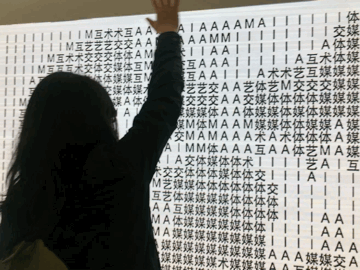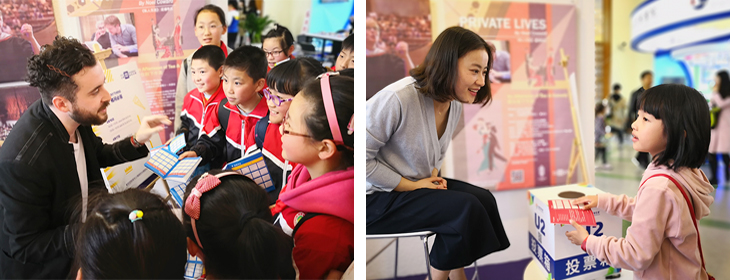This week, NYU Shanghai showcased its arts programs at the 15th Shanghai Education Expo, held at the Shanghai Exhibition Center from April 16 to 18.
Joining peer universities and colleges from around China, the NYU Shanghai booth displayed images, videos, and interactive installations featuring its distinctive curriculum and innovative practices in art education in multiple fields, ranging from interactive media arts (IMA), to dance, drama and music.

More than 140,000 educators, students and parents from across the country attended the event, which aimed to show the progress of arts education in China.
On its opening day, the NYU Shanghai booth attracted a crowd of elementary school kids intrigued by the interactive artworks on display. One highlight was an interactive installation called the Mandarinizer by IMA Associate Fellow Jack B. Du, which transformed the reflection of any person or object in front of it into thousands of Mandarin Chinese characters.

The NYU Shanghai booth also welcomed a visit from the leadership of the CPC Shanghai Education and Health Work Committee, and the Shanghai Municipal Education Commission, who saluted the University’s achievements in arts education.
Chancellor Yu Lizhong said the booth “demonstrated the multi-cultural integration of arts education at NYU Shanghai.”
In addition to demonstrations in the booth, Professors Antonius Wiriadjaja, Rodolfo Cossovich and IMA Fellows Chang Liu, Jiwon Shin, Jack B. Du and Luis Morales-Navarro, joined a panel discussion introducing NYU Shanghai’s interdisciplinary curriculum and the IMA program.
“Students of the IMA program may have come from different disciplinary backgrounds, but they are passionate about broadening their vision,” said Professor Cossovich. “We encourage our students to explore the possibilities of emerging technologies to connect people, convey information, tell stories, enhance experiences and therefore make a joyous difference to our lives,” he added.

Meanwhile on the opposite spectrum, Professors Zhang Jian-Jun and Barbara Edelstein presented how traditional methodologies and contemporary art inform their collaborative processes. Some of their most noted artworks include an industrial copper and bronze sculpture inspired by the willow leaves of Jing’an Park, and an art performance titled “Hongkou Stones,” which traces the history of Jewish refugees in Shanghai during World War II.
“We use cross-cultural materials. Jian-jun uses oil paintings. I use Chinese ink...so there is a new synthesis. It is no longer just Chinese or just Western,” Edelstein said.
Their classroom teaching styles at NYU Shanghai introduce the same principle—for example using traditional Chinese tools and mediums at the start of a semester and switching to contemporary western figure drawing in the next.
“We push our students to work from their very different backgrounds and interests, allowing their own experiences to shape their artwork,” said Zhang. “Throughout, we emphasize tradition, contemporary ways and finally the connection to personal experience.”


